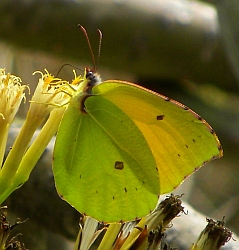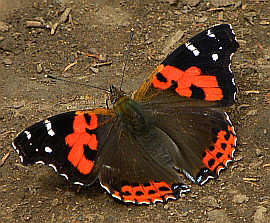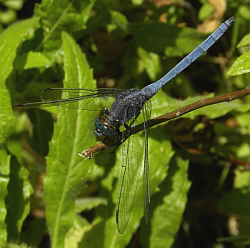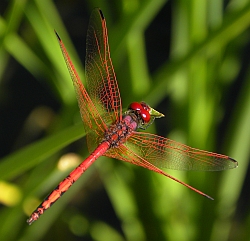 |
Natural History of the
Canary Islands – part 5
by Teresa Farino and John Muddeman
Canary flora and invertebrates
-Roque-de-Agando-La-Gomera.jpg) Aeonium rubrolineatum (A. arboreum) Aeonium rubrolineatum (A. arboreum)
Roque de Agando, La Gomera© Teresa Farino
FLORA
The flora of the Canary Islands is simply remarkable, numbering around 1600 native taxa, of which around 680 are endemic, particularly within the genera Aeonium (Crassulaceae), Echium (Boraginaceae), Micromeria and Sideritis (Labiatae) and Argyranthemum (Compositae), each of which contains more than 20 species unique to the archipelago. Even more extraordinary is the fact that the islands harbour no less than 22 endemic genera, including Dicheranthus (Caryophyllaceae), Greenovia (Crassulaceae), Parolinia (Cruciferae), Spartocytisus (Leguminosae), Neochamaelea (Cneoraceae), Ixanthus (Gentianaceae), Ceballosia (Boraginaceae), Plocama (Rubiaceae) and Vieraea and Atalanthus (Compositae).
Because they grow on remote islands, these endemic plants have nowhere to go if things get rough, such that the ill-considered placement of a single tourist resort could wipe out a whole species. Of the 1,414 variously threatened plants that make up the Red List of Spanish Vascular Flora, published in 2000, 458 occur only in the Canary Islands within Spanish territory. Compare this to the 845 taxa cited for the whole of the Spanish mainland, and it is clear that the Canary flora has its back against the wall.
 Parolinia ornata© Teresa Farino Parolinia ornata© Teresa Farino
It has been estimated that almost 70 per cent of the Canary endemic flora is in danger of extinction. Some of the most severely threatened plants of the archipelago,
 Vieraea laevigata© Teresa Farinowith less than a dozen individuals surviving in the wild, are the rock-roses Helianthemum aganae from La Gomera and Helianthemum inaguae from Gran Canaria, three distinctive birdsfoot-trefoils - Lotus eremiticus and L. pyranthus on La Palma and L. maculatus from Tenerife - and the labiate Sideritis amagroi, again from Gran Canaria. Sadly, the Tenerife endemic shrub Kunkeliella psilotoclada (Santalaceae) has not been seen since 1983, and is probably extinct - a victim of uncontrolled livestock grazing on the island - with Normania nava (Solanaceae), which formerly grew in the laurel forests of Anaga, again on Tenerife, following suit in 1984. Vieraea laevigata© Teresa Farinowith less than a dozen individuals surviving in the wild, are the rock-roses Helianthemum aganae from La Gomera and Helianthemum inaguae from Gran Canaria, three distinctive birdsfoot-trefoils - Lotus eremiticus and L. pyranthus on La Palma and L. maculatus from Tenerife - and the labiate Sideritis amagroi, again from Gran Canaria. Sadly, the Tenerife endemic shrub Kunkeliella psilotoclada (Santalaceae) has not been seen since 1983, and is probably extinct - a victim of uncontrolled livestock grazing on the island - with Normania nava (Solanaceae), which formerly grew in the laurel forests of Anaga, again on Tenerife, following suit in 1984.
INVERTEBRATES
The level of endemism displayed by the Canary Island invertebrate communities is perhaps even more astounding than that of the flora, with all the principal habitats harbouring species that are found nowhere else in the world.
 Pseudoyersinia teydeana, Pseudoyersinia teydeana,
Las Cañadas del Teide, Tenerife© Teresa FarinoNot surprisingly, this is particularly the case at altitude, where the geographically isolated subalpine and alpine zones on Tenerife and La Palma have given rise to dozens of endemic genera, many of them flightless, with new species being discovered every year.
Among the many Canary endemic species of grasshoppers and crickets, perhaps the most eye-catching are the huge, chunky members of the genus Acrostira, also flightless, which are represented by different species on La Gomera, Tenerife and La Palma. The related Purpuraria erna, which is listed as Vulnerable in the Spanish Red Data Catalogue, is confined to more vegetated badlands of Fuerteventura and Lanzarote, where it feeds primarily on the tree-spurges Euphorbia obtusifolia and E. regis-jubae.
 La Gomera Brimstone La Gomera Brimstone
Gonepteryx eversi© Teresa Farino
Butterflies
Better known are the many species of Canary endemic butterflies, with species typical of the laurisilva including Canary Red Admiral (Vanessa vulcanica) and Canary Brimstone (Gonepteryx cleobule), the latter considered Vulnerable on the 2011 IUCN Red List of Threatened Species. More widespread Canary endemics include the Canary Blue and Canary Speckled Wood (Pararge xiphioides), found in almost every habitat, from sea level to more than 2500 metres, and the skipper Thymelicus christi.
 Gomera Grayling Hipparchia gomera© Teresa Farino Gomera Grayling Hipparchia gomera© Teresa Farino
Recent taxonomic revision has identified a separate species of grayling for each of the western and central islands of the Canary archipelago: El Hierro Grayling (Hipparchia bacchus), La Palma Grayling (H. tilosi), Gomera Grayling (H. gomera), Canary Grayling (H. wyssii), which occurs only on Tenerife, and Gran Canaria Grayling (H. tamadabae). Similarly, butterflies of the genus Euchloe in the Canaries have also been split, with the Canary Green-striped White (E. hesperidum) confined to Fuerteventura, E. grancanariensis known only from Gran Canaria, and E. eversi, described only in 2008, restricted to habitats above 2000 metres on Tenerife.
 Canary Red Admiral Vanessa vulcanica© Teresa Farino The Endangered Canary Islands Large White (Pieris cheiranthi) is nowadays probably extinct on La Gomera, although it is widespread and locally common on La Palma, and also occurs along the northern coastal reaches of Tenerife. Canary Red Admiral Vanessa vulcanica© Teresa Farino The Endangered Canary Islands Large White (Pieris cheiranthi) is nowadays probably extinct on La Gomera, although it is widespread and locally common on La Palma, and also occurs along the northern coastal reaches of Tenerife.
Other notable Canary butterflies include the Canary Migrant (Catopsilia florella), Greenish Black-tip (Euchloe charlonia), Monarch (Danaus plexippus) and Plain Tiger (D. chrysippus), with more widespread European species such as Clouded Yellow (Colias crocea), Bath White (Pontia daplidice), Long-tailed and African Grass Blues (Lampides boeticus and Zizeeria knysna, respectively), Painted Lady (Vanessa cardui) and Red Admiral (V. atalanta) found on all the islands, while the Queen of Spain Fritillary (Issoria lathonia) is confined to La Gomera, Tenerife and La Palma.
Dragonflies
Although there are no true Canary endemics among the odonates, damselflies such as the Ubiquitous Bluetail (Ischnura senegalensis), Sahara Bluetail (I. saharensis) and Barbary Featherleg (Platycnemis subdilatata) are essentially African species that occur nowhere else in Europe.  Male Epaulet Skimmer Male Epaulet Skimmer
Orthetrum chrysostigma© Teresa FarinoAmong the North African dragonflies that have made the short crossing to the Canary archipelago are the handsome Red-veined Dropwing (Trithemis arteriosa), which also occurs in southern Turkey, Ringed Cascader (Zygonyx torridus), which is extending its range northwards from the Mediterranean into Iberia and Sicily, and Epaulet Skimmer (O. chrysostigma), which has recently reached northern Portugal, as well as colonising the Greek islands bordering Turkey.
 Male Red-veined Dropwing Male Red-veined Dropwing
Trithemis arteriosa© Teresa Farino
More widespread European species which have an outpost in the Canaries include Blue Emperor (Anax imperator), Lesser Emperor (A. parthenope), Broad Scarlet (Crocothemis erythraea) and Red-veined Darter (Sympetrum fonscolombii). The Island Darter (Sympetrum nigrifemur), which some authors consider to be a subspecies of Common Darter (S. striolatum), occurs in both the Canary Islands and Madeira.
|